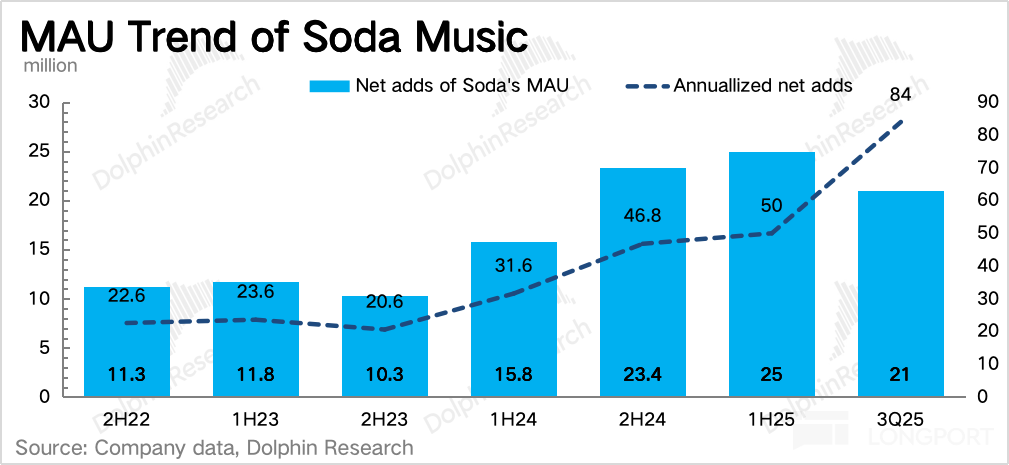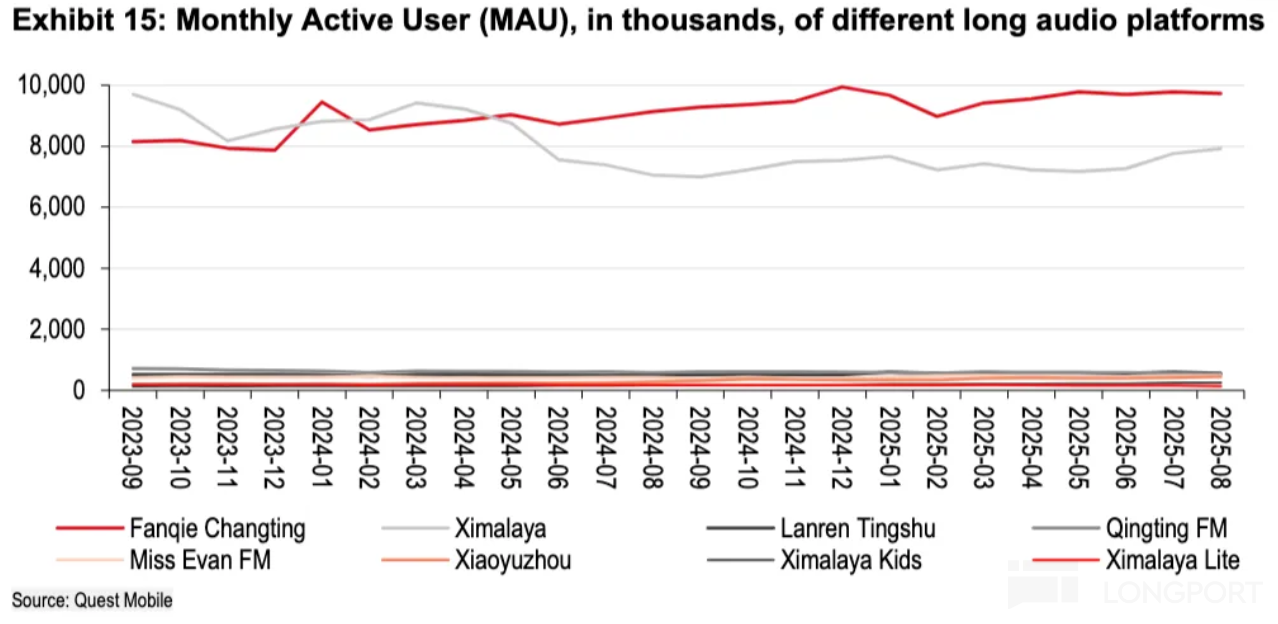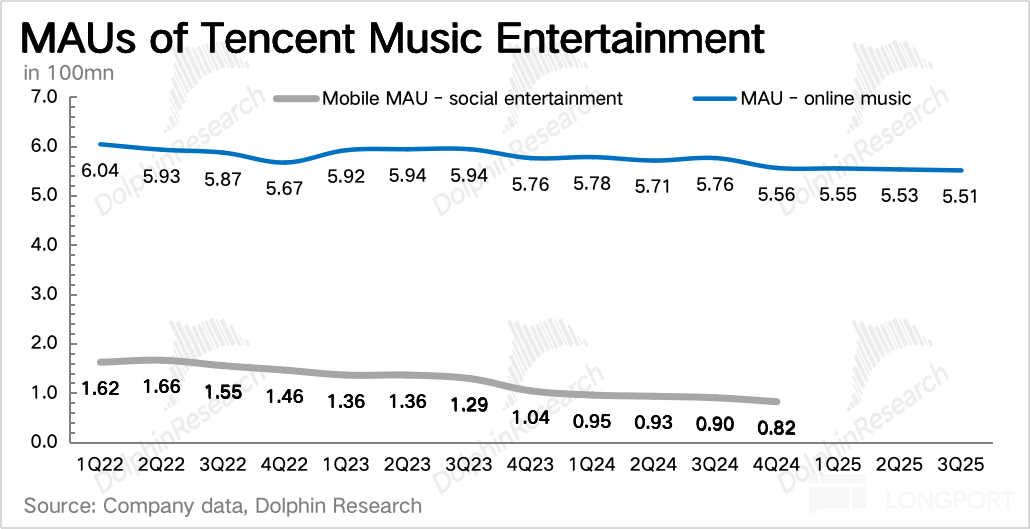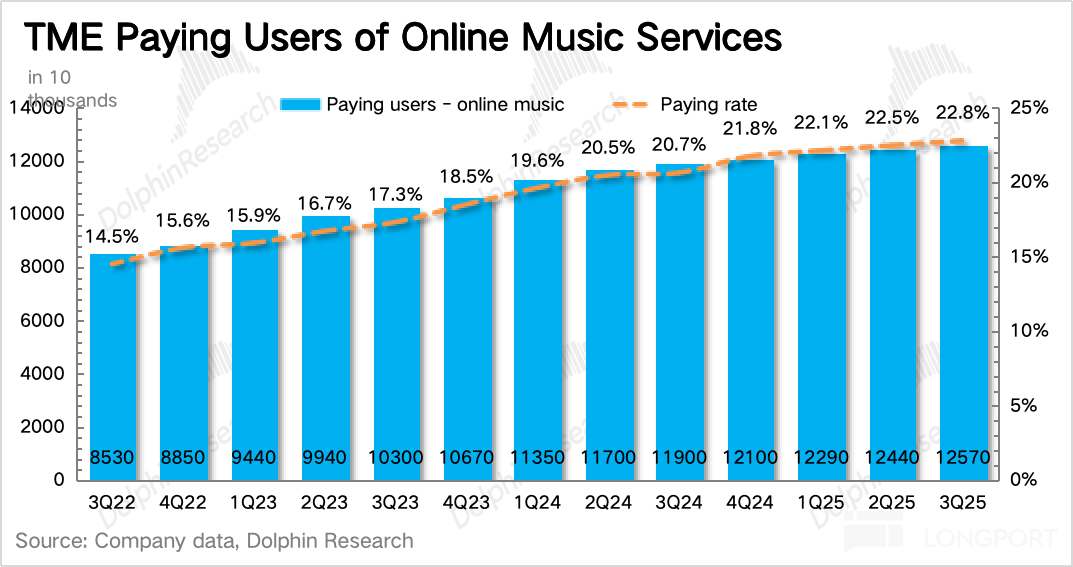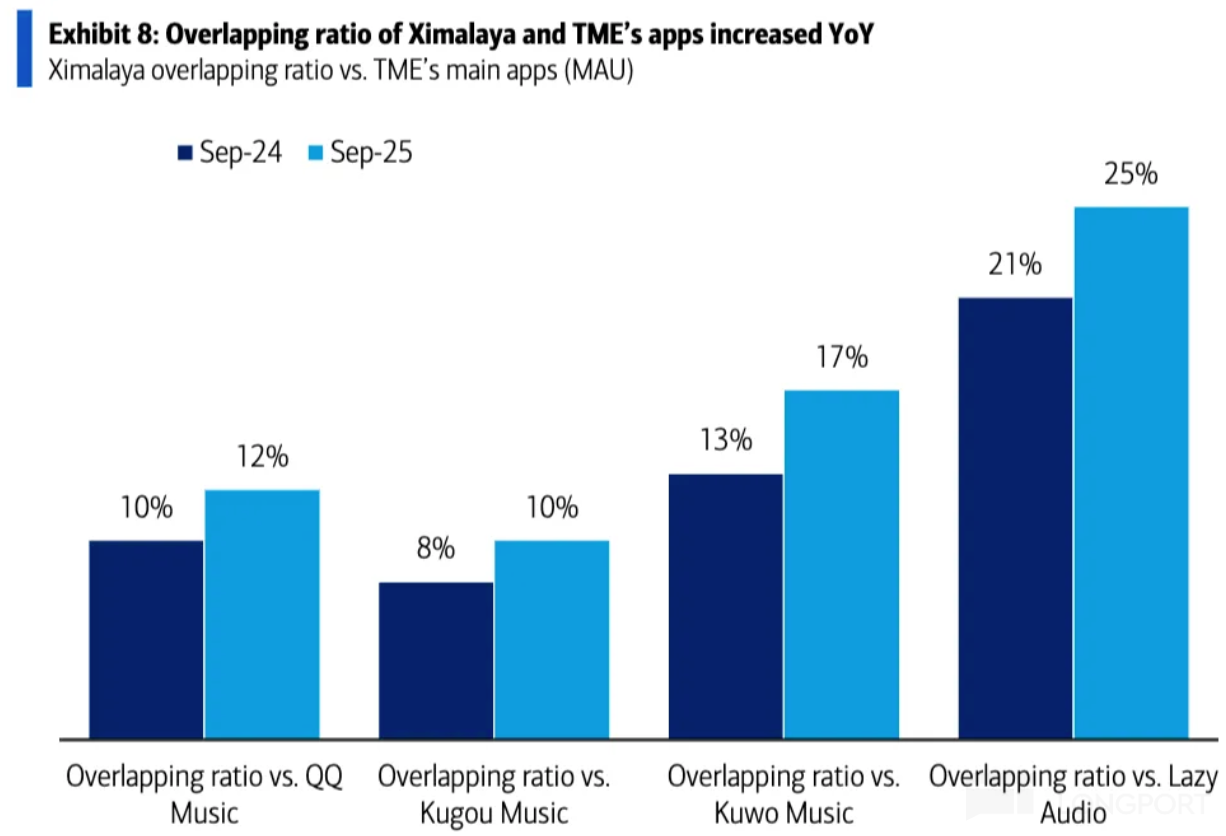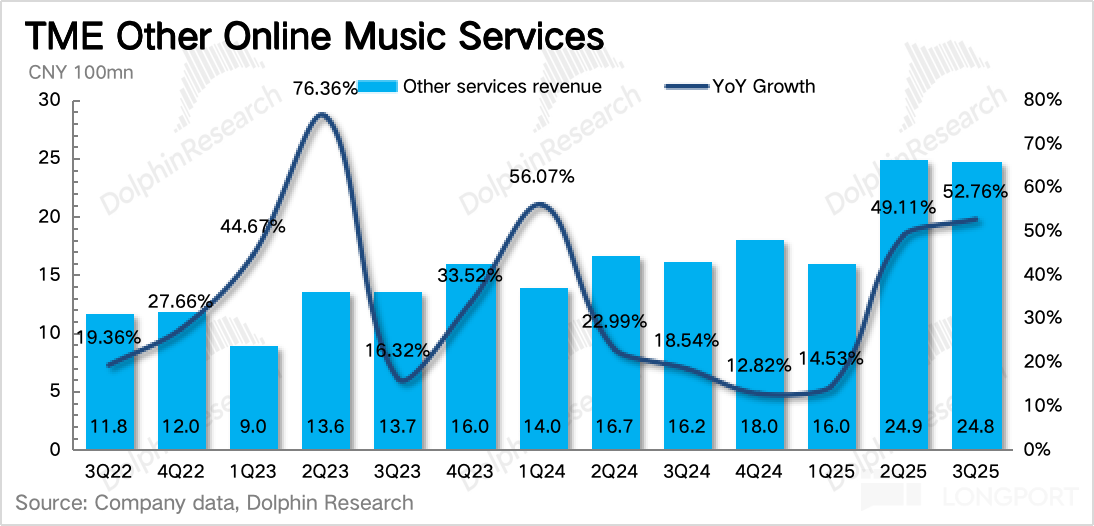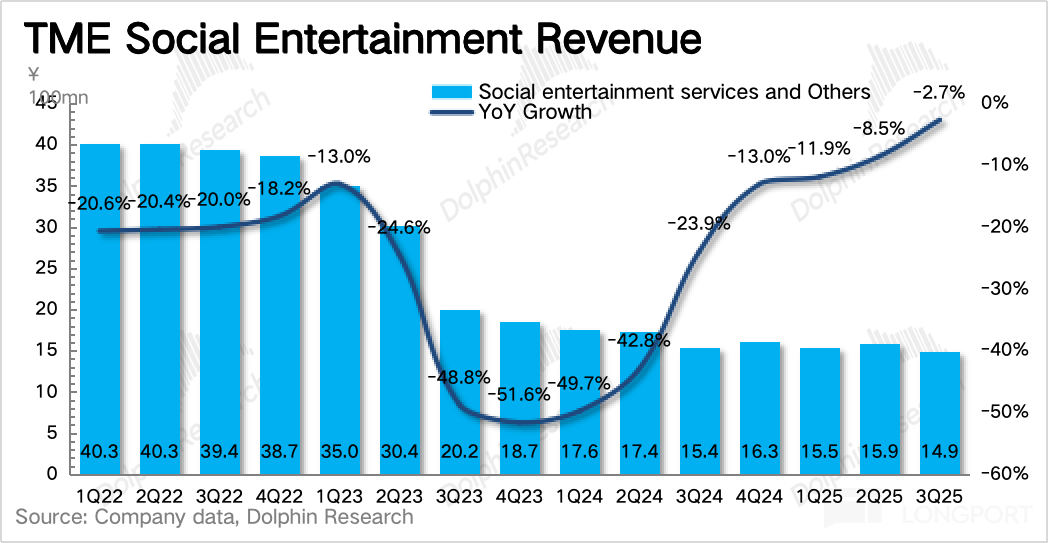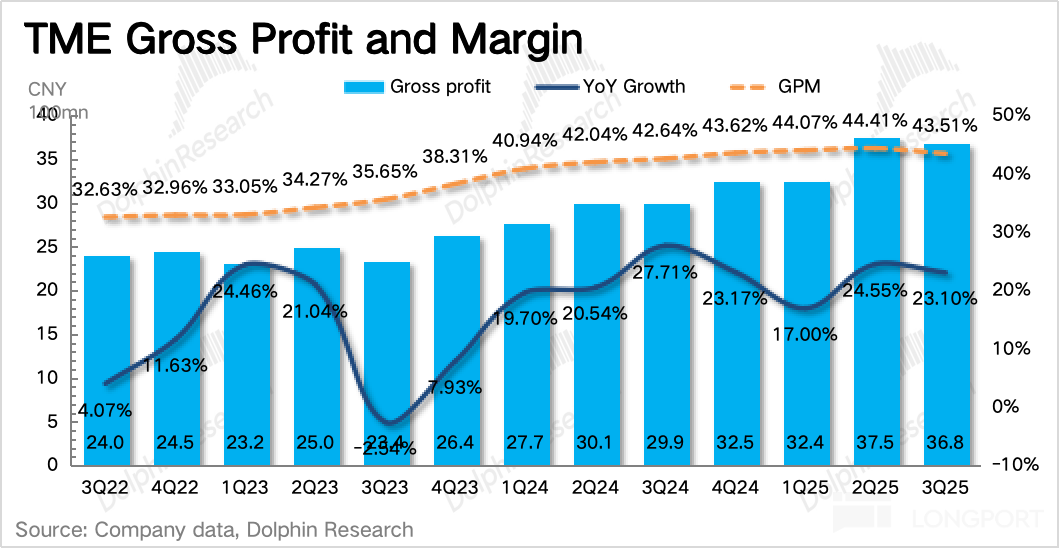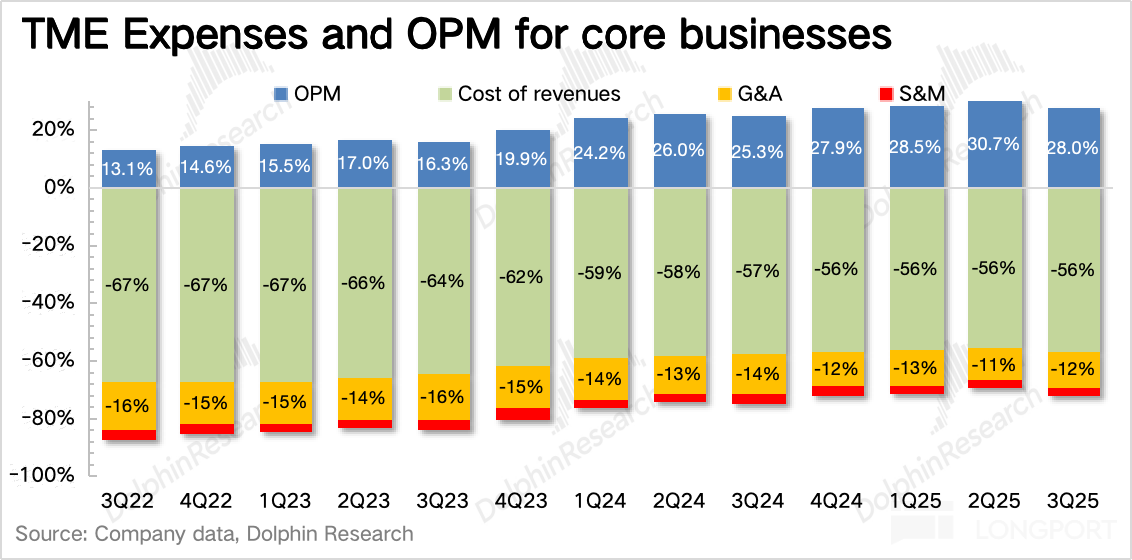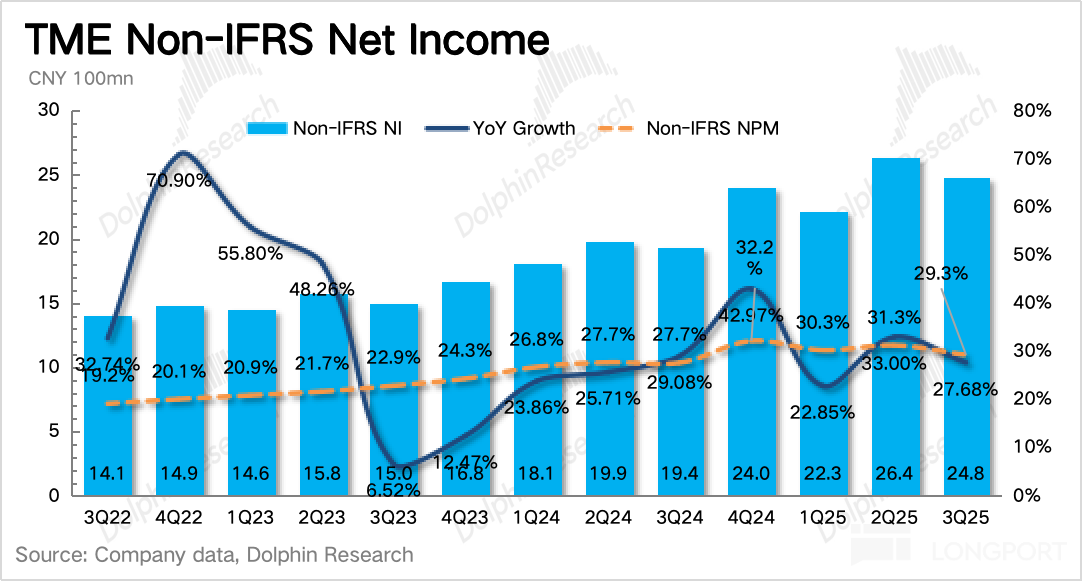
ByteDance makes a push, can Tencent Music still be 'small and beautiful'?

On November 12, Beijing time, after the Hong Kong stock market closed and before the U.S. stock market opened, $Tencent Music(TME.US) $TME-SW(01698.HK) (TME.N;$TME-SW(1698.HK)) released its financial report for the third quarter of 2025. Overall, it exceeded expectations, particularly with the partial realization of the second growth curve story.
However, there are flaws, such as the continued slowdown in net subscription growth, which indirectly confirms the market's pre-report concerns about intensified competition. Currently, there is still a significant difference between the core users of Tencent Music and ByteDance (Tencent Music vs. ByteDance = high-tier music essential users vs. lower-tier Douyin hit song users), which gives Tencent Music some time for adjustment and consolidation. How to specifically respond? You can pay attention to the conference call later.
Let's first look at the financial report:
1. Can stable subscription growth continue?: Subscription revenue grew by 16% in the third quarter, with a net increase of 1.3 million subscription users, and an average payment of 11.9 yuan/month per user, with growth further shifting from "volume" (+6%) to "price" (+10%).
This reflects one of the core growth points—SVIP penetration driving premium payments through enriched membership benefits (content, functions), and there is no issue with this growth logic. As Dolphin Research previously mentioned, when competition is stable, whether driven by volume or price, the initiative is in the company's hands, allowing for flexible adjustments during different seasons.
However, the continued decline in new subscription numbers still reflects the issue of the existing ecosystem reaching its peak or even beginning to lose ground, which is essentially brought about by competition. This is also the core reason for the continuous adjustment of Tencent Music's stock price before the financial report. Maintaining stable subscription revenue growth (long-term 10%-15%) is a key support for the long-term 20x PE valuation. ByteDance's significant actions in the third quarter can be noted in the conference call for management's views on competition and response measures.
2. Is the second curve taking shape?: Other music revenue exceeded expectations again in the third quarter, accelerating growth by 53%, mainly from ticket and peripheral sales of multiple artists' offline concerts. In addition, advertising, albums, and the launch of Bubble in June should also have made significant contributions.
Expanding value coverage by delving into the upstream and downstream of the music industry chain is Tencent Music's main direction, with IP derivatives including concerts, albums, and fan economy being key focuses, representing the second growth curve for Tencent Music beyond subscription services.
3. Social entertainment continues to recover: Revenue from live streaming, karaoke, etc., declined by 3% in the third quarter, with the downward trend continuing to slow, and is expected to gradually return to positive growth. However, this business involves regulatory and industry downturn trends, and it is not a future focus, with the main goal being to maintain stability, but comprehensive gross margin can be driven by reducing revenue sharing.
4. Is the profit margin improvement slowing down?: After three years of restrained operating expenses, this quarter "finally" saw an uptick. However, it is still in the low growth range, with an 8% year-on-year increase. In absolute terms, the increase is mainly due to administrative expenses (including R&D). Dolphin Research believes that the increase in expenses indicates Tencent's strong desire for the second growth curve, reflected in recruitment expenditures.
Ultimately, although the core business's operating profit is still growing at a high rate of 34% year-on-year, the profit margin is no longer improving and has decreased by 2 percentage points quarter-on-quarter. Adjusted profit was 2.48 billion, slightly exceeding market expectations.
5. Will long audio break through the existing ecosystem?: Finally, let's look at the traffic pool. Monthly active users (MAU) in the third quarter were 551 million, with a loss of 2 million users quarter-on-quarter. Soda Music continued to grow against the trend, especially with significant acceleration in the third quarter, reaching over 120 million MAU by the end of the third quarter (source: QM). Although the average duration per user is not as high as Tencent Music's platforms, it is already comparable to Cloud Music and is still slowly rising.
6. Cash remains abundant: As of the end of the third quarter, Tencent Music had net cash of 22.3 billion yuan (cash + short-term investments - short and long-term interest-bearing debt), equivalent to 3.2 billion USD. No new actions were disclosed for the 1 billion USD repurchase announced in March.
7. Detailed financial data overview

Dolphin Research's View
After the second-quarter financial report, Tencent Music reached a peak of 41 billion USD within a month, then began to decline, with a 20% drop by yesterday's closing price, and doubts began to resurface. "Industry growth reaching its peak" + "marginal changes in the competitive landscape" are the main points of contention, with the latter, the change in competition, being the core trigger for the continuous adjustment over the past month.
1. Industry growth issue: Not the focus for now. This is an old issue derived from consumption downgrading, with doubts peaking in mid-2024, triggered by Tencent Music lowering its guidance for new paid subscriptions in the third and fourth quarters, with net additions dropping from 3-5 million per quarter (except Q1 due to special promotions reaching 6.8 million) to the 1-2 million range. Meanwhile, ARPPU also fell to low single digits, indicating that slowing the "price increase" pace did not bring more paid users.
The situation is similar for the second-tier player. Although Cloud Music stopped disclosing operational data last year, combined with third-party data like QM (MAU growth stagnation) and Cloud Music's simultaneous price increase actions and subscription revenue growth slowdown, Cloud Music has likely completed the easiest monetization phase and is now entering the stage of finding a second curve like Tencent Music. However, after the Q2 financial report, Cloud Music's stock price also fell back, with a 30% adjustment. Besides differences in liquidity and market location, the decline in Cloud Music is likely related to the second point, competition.
2. Marginal changes in the competitive landscape: Concerns are increasing. In our 4Q24 review at the beginning of the year, we suggested that the main focus for music streaming this year might be changes in competition. This is because, according to QM data, Soda Music reached 90 million users at the beginning of the year, a user accumulation completed in three years. On a semi-annual basis, the net increase from 2H22 to 1H25 showed a significant acceleration trend in 2024. Especially from 2H23 to 2H24, the net increase grew by 50% quarter-on-quarter.
Generally, for platform businesses, reaching 50 million DAU is a milestone stage where an ecosystem can remain stable and have long-term monetization value. Due to the traffic redirection from Douyin, Soda's user stickiness (DAU/MAU) can reach 30%, so 50 million DAU corresponds to a scale of 150 million MAU.
Our initial assumption was that if the net increase continued at the above growth rate (50% quarter-on-quarter), there was hope for a net increase of 70 million in H1 2025, meaning Soda Music would reach a milestone. Therefore, if Soda further increases investment and Douyin redirects traffic, the scale by the end of the year might even surpass the second-tier Cloud Music.
In reality, Soda Music only had a net increase of 25 million in the first half of this year, which slightly eased Dolphin Research's competition concerns. But the situation changed, with Soda users suddenly accelerating growth after entering August and September, with a net increase of over 20 million in just one quarter. Dolphin Research believes that the reasons for the accelerated growth, besides increased buying and Douyin exposure redirection, also include some help from cooperation with Jay Chou (Jay Chou joined Douyin in July, and Douyin currently holds MV rights).

On November 7, ByteDance launched the "Tomato Music" app, which is the music section spun off from "Tomato Listen," following the same growth path as all ByteDance apps, focusing on being free. The difference between "Tomato Music" and "Soda Music" lies in the core user groups, with Soda Music targeting young users (concentrated in the 18-35 age group, with students accounting for 47%, and Douyin hit songs and niche music being key audiences), while "Tomato Music," as experienced by Dolphin Research, seems to temporarily target middle-aged and elderly users, with old songs dominating the recommendation list, along with a mix of short dramas and audiobooks.
In other words, ByteDance is once again using its expertise in the app factory model, using Douyin as a central platform to deliver traffic and support, attacking peers from multiple angles. Among them:
1) Soda vs. Cloud Music: In the general direction, Soda avoids the temporary disadvantage of copyrighted music by not following the old path of top copyrighted music but instead leveraging its advantage in Douyin hit songs, signing niche singers and composers, which not only saves costs but also delves deeper into the industry chain.
This is similar to Cloud Music's route, which also emphasizes the number of independent musicians and platform-recommended niche songs as advantages, and at the same time, there is more overlap with the core user group, which is mainly students. Therefore, in the face of Soda's impact, Dolphin Research believes Cloud Music is the first to be affected.
2) Tomato Music vs. Tencent Music: Tomato focuses on copyrighted old songs, with some overlap with Tencent Music in classic Chinese songs. Although Tomato is relatively disadvantaged in terms of music library resources (for example, Tencent Music has always had an advantage in Korean songs), Tencent Music is not entirely safe. At the very least, ByteDance's low-price advantage will hinder Tencent Music's paid conversion improvement and "price increase" trend, and in terms of growth stories, the missing piece of the lower-tier market MAU for TME is also being preemptively penetrated by ByteDance.
Overall, the industry growth issue has not been proven for the time being. Although the short-term impact on residents' consumption is inevitable due to the macro environment, there is still room for improvement in payment rates and ARPPU based on the core users' payment power and by bundling more content and developing new functions to enrich membership benefits.
However, the competition issue needs to be paid attention to. Since ByteDance has started to take action, subsequent changes are not over yet, but we suggest taking it step by step, as there are still differences in the consumption habits of core users. Therefore, do not underestimate the long-term impact, but also do not exaggerate the short-term impact.
Currently, the three new growth stories Tencent Music is telling—SVIP, fan economy, and long audio—are all steadily advancing in the third quarter. SVIP is driving the monetization value of core users, and other income under the fan economy is accelerating growth.
Competition may relatively affect the penetration pace of SVIP, but from the perspective of industry cultivation and commercial demand differences, the fan economy is temporarily unaffected; the acquisition of Ximalaya is still awaiting regulatory approval for long audio. Although the current user scale is no longer comparable to "Tomato Listen," the low user overlap rate of 10%-15% suggests that the merger could bring some new increments. Due to regulatory and integration uncertainties, the market expectation currently does not include this part.
In terms of valuation, after adjustments due to the dual impact of the market and competition, the current 32.1 billion USD is in the neutral range of 23x P/E this year and 20x P/E next year. Note that this expectation does not include the integration effect of Ximalaya, so theoretically, there is still room. But on the other hand, if competition further intensifies (as seen in Q3, ByteDance is not making small moves), although it has not yet reflected in short-term performance, concerns will affect the valuation multiple from further upward, as it has in the past year, resulting in more excess returns.

Detailed Analysis Below
I. User Ecosystem: MAU is still declining, and paid net increase is slowing down
MAU continued to decline by 2 million users in the third quarter, reaching 551 million. The net increase in music paid users was 1.3 million, reaching 126 million, with a payment rate of 22.8%, slightly improving quarter-on-quarter. However, since MAU has been declining, losing non-core marginal users, the payment rate is bound to rise, and looking at the payment rate alone without considering MAU loses comparative significance.


In the industry, the decline in ecosystem users is more apparent. Meanwhile, Soda Music has been rising against the trend, with a steeper growth slope in the third quarter, reaching 120 million users by the end of September. However, they are still new users redirected, and the overall daily user active duration remains relatively low. Nevertheless, it is already comparable to Cloud Music.

II. Online Music: Subscription has hidden concerns, and the second curve is taking shape
1. Subscription: SVIP penetration is key, and ecosystem expansion is equally important
Subscription revenue grew by 16% in the third quarter, with a net increase of 1.3 million subscription users, and an average payment of 11.9 yuan/month per user, with growth further shifting from "volume" (+6%) to "price" (+10%). The price increase is due to SVIP penetration, with 15 million users last quarter accounting for 12% of total subscriptions, and Dolphin Research estimates the penetration rate this quarter to be 13% (pending Callback confirmation), with the increase not being too fast.
As the pillar of revenue, maintaining stable subscription revenue growth (long-term 12%-15%) is a key support for the long-term 20x PE valuation. The problem is that if the current Q3 quarter-on-quarter "price increase" rate is followed, next year's ARPPU growth rate will also slow to 5%-10%. In this case, the overall subscription revenue growth can only be maintained at around 10%.
The above growth contradiction reflects the issue of the existing ecosystem reaching its peak or even beginning to lose ground, which is essentially competition. To alleviate this, one direction is to refine the product and continue to enhance user experience, similar to the competitive advantage Spotify demonstrated when facing competition from platforms under giants. Another direction is to look forward to the new users brought by the merger with Ximalaya. After all, the core user overlap between the two platforms is only 10%-15%, but music as a universal demand, if sold in a bundle (e.g., existing membership with an additional 1-2 yuan premium), user payment conversion is not difficult.



2. Other music services: Growth contribution is increasing
Other music services in the third quarter exceeded expectations, accelerating growth by 53% to 2.5 billion, already accounting for 30% of total revenue.
This part includes advertising, digital album sales, copyright sublicensing, value-added services, etc., mainly benefiting from multiple artists' offline concerts in the third quarter. This belongs to the IP derivative peripheral business around fan value monetization, although the audience scale is far smaller than the music essential audience, the per capita value is very high, and the consumption power of China's core users in this part is not inferior to that of Europe and the United States.

3. Social entertainment: Continue to recover, maintain stability in the future
Revenue declined by 3% in the third quarter, with the downward trend continuing to slow, and is expected to gradually return to positive growth. However, this business involves regulatory and industry downturn trends, and it is not a future focus, with the main goal being to maintain stability, but comprehensive gross margin can be driven by reducing revenue sharing.

III. Profit: Profit improvement is temporarily paused, investment in the new curve is more important
The gross margin in the third quarter slightly declined quarter-on-quarter, possibly due to the inherently low gross margin of other music services, but the fastest growth this quarter increased its revenue share.
On the expense side, growth was "finally" seen, with an 8% year-on-year increase. In absolute terms, the increase is mainly due to administrative expenses (including R&D). Although the profit margin improvement has temporarily stopped, Dolphin Research tends not to interpret this phenomenon negatively.
Currently, it is a stage that requires strengthening the narrative of the second growth curve. Although the second curve itself cannot compare with subscription in terms of profit margin, once the investment period is over, Tencent Music can rely on the upstream and downstream linkage of the industry chain to reduce intermediate friction and move towards becoming a global music giant.
Ultimately, although the core business's operating profit is still growing at a high rate of 34% year-on-year, the profit margin is no longer improving and has decreased by 2 percentage points quarter-on-quarter. Adjusted profit was 2.48 billion, slightly exceeding market consensus expectations due to interest and other miscellaneous items.



<End here>
Dolphin Research's "Tencent Music" related research review over the past year:
Earnings Season
August 12, 2025 Minutes "Tencent Music (Minutes): Strong growth momentum will continue into Q3"
August 12, 2025 Earnings Review "Tencent Music: A vertical bull stock, an inexhaustible gold mine?"
May 13, 2025 Minutes "Tencent Music (Minutes): More emphasis on long audio than podcasts"
May 13, 2025 Earnings Review "Tencent Music: New growth cycle, falling into mediocrity or steady happiness?"
March 18, 2025 Conference Call "Tencent Music (Minutes): Room for profit margin improvement"
March 18, 2025 Earnings Review "Tencent Music: Small happiness reappears during pressure period"
November 12, 2024 Conference Call "Tencent Music: How is the progress of the next growth driver SVIP? (3Q24 Conference Call Minutes)"
November 12, 2024 Earnings Review "Tencent Music: How far can the price increase logic go?"
August 13, 2024 Conference Call "Tencent Music: What supports performance after the slowdown in net membership growth? (2Q24 Performance Conference Call Minutes)"
August 13, 2024 Earnings Review "Tencent Music: Small flaws but a sharp drop, was it wrongly killed?"
May 13, 2024 Earnings Review "Tencent Music: An inexhaustible gold mine? The charm of small and beautiful verticals"
March 19, 2024 Conference Call "Tencent Music: The effect of early-year promotions exceeded expectations (4Q23 Conference Call)"
March 19, 2024 Earnings Review "Tencent Music: The leader with a BUFF, price increase against the cycle"
November 17, 2023 Conference Call "The space for music subscriptions is still vast (Tencent Music 3Q23 Conference Call Minutes)"
November 14, 2023 Earnings Review "Tencent Music: The small and beautiful hidden by the shadow of live streaming"
August 15, 2023 Conference Call "The impact of live streaming adjustments is expected to stabilize by the end of the third quarter (Tencent Music 2Q23 Conference Call Minutes)"
August 15, 2023 Earnings Review "Tencent Music: Business adjustments, continue to grind the bottom"
March 22, 2023 Conference Call "No hard injuries in performance guidance, just too full expectations (Tencent Music 4Q22 Conference Call Minutes)"
March 21, 2023 Earnings Review "Tencent Music: Without growth, can "saving" support the big dream of music?"
Hot Topics
June 10, 2025 Hot Comment "Tencent Music keeps buying, is the music kingdom boundless?"
In-depth
April 12, 2023 "Douyin and Tencent's off-site marriage, is there a solution to the deadlock in entertainment payments?"
January 6, 2023 "A "good start" for pan-entertainment, whose rebound is more lasting, Tencent or Bilibili?"
The risk disclosure and statement of this article: Dolphin Research Disclaimer and General Disclosure
The copyright of this article belongs to the original author/organization.
The views expressed herein are solely those of the author and do not reflect the stance of the platform. The content is intended for investment reference purposes only and shall not be considered as investment advice. Please contact us if you have any questions or suggestions regarding the content services provided by the platform.



